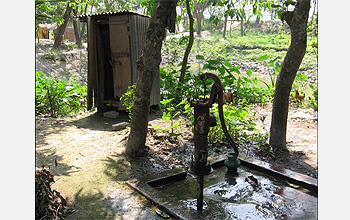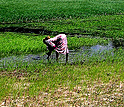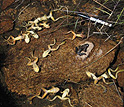News Release 07-157
NSF, NIH Award Ecology of Infectious Diseases Grants
Scientists to study interaction of environment, disease processes

Village groundwater supplies in Bangladesh may foster arsenic poisoning and infectious diseases.
October 29, 2007
This material is available primarily for archival purposes. Telephone numbers or other contact information may be out of date; please see current contact information at media contacts.
Over the last several decades, environmental changes have coincided with the emergence and re-emergence of numerous infectious diseases around the world.
To address this problem, the National Science Foundation (NSF)'s Directorates for Biological Sciences, Geosciences and Social, Behavioral, and Economic Sciences and the National Institutes of Health (NIH)'s Fogarty International Center (FIC) and National Institute of Environmental Health Sciences have announced funding for eight projects under the Ecology of Infectious Diseases (EID) program, a multiyear, joint-agency effort now in its eighth year of funding.
"Understanding the causes and consequences of emerging infectious diseases is among the grand challenge questions in the environmental sciences," said James Collins, NSF assistant director for biological sciences. "These awards will help provide the basic knowledge we need to develop models for forecasting the emergence and spread of new and old pathogens."
"These projects will help ecologists discover basic insights about disease transmission, and help public health officials make complex decisions about disease prevention measures and their potential trade-offs with other environmental health risks," said Roger Glass, director of NIH's FIC.
Interdisciplinary projects funded through the EID program will study how environmental events--such as habitat destruction, biological invasions, and pollution--alter the risks of viral, parasitic and bacterial diseases now emerging in humans and animals.
The coincidence of the emergence of these infectious diseases and large-scale environmental changes may point to underlying and predictable ecological relationships, said Sam Scheiner, program director in NSF's division of environmental biology. "Fundamental research is critical for preparing for possible disease outbreaks, as well as for optimizing public health and environmental management responses to chronic infectious diseases," he said.
"The involvement of geoscientists as well as bioscientists is central to the study of infectious diseases," said Fred Lipschultz, program director in NSF's division of ocean sciences. "Many diseases are modulated by physical factors such as the circulation of air and water, and increasingly, by changes in climate."
The research will contribute knowledge and analytical tools that will help public-health officials, wildlife managers, farmers and others to control the spread of diseases among humans, domestic and wild animals, and crops, say EID scientists.
Benefits of the EID program, said Joshua Rosenthal, program director at the NIH FIC, include development of disease transmission theory; improved understanding of unintended health effects of development projects; increased capacity to forecast outbreaks; and improved understanding of how diseases emerge and re-emerge.
This year's EID awards are:
- African buffalo (Syncerus caffer) co-infected with bovine tuberculosis and gastrointestinal nematodes as a model system to investigate individual-level patterns of infection and parasite population dynamics, will be studied by Vanessa Ezenwa of the University of Montana and colleagues.
- West Nile Virus in New York City and its spread over the past seven years will be studied by John Drake of the University of Georgia and colleagues. They will identify links between the ecology of an urban environment and the public health of 10 million New Yorkers.
- An emerging infectious disease in amphibians called chytridiomycosis, caused by the fungal pathogen Batrachochytrium dendrobatidis, and implications of this disease as a major cause of amphibian declines and extinctions around the world, will be researched by Cheryl Briggs of the University of California at Santa Barbara and Craig Moritz of the University of California at Berkeley.
- Fishing pressure and habitat degradation are severe and pervasive threats to coastal marine ecosystems, say Mark Butler of Old Dominion University and Jeffrey Shields of the Virginia Institute of Marine Sciences. Butler and Shields will study how these parameters combine with the hydrography of small coastal estuaries on the Delaware-Maryland-Virginia (Delmarva) peninsula to promote outbreaks of a pathogenic parasite, Hematodinium, affecting blue crabs.
- Bobcats, puma, and domestic cats will be evaluated in three ecosystems--high mountain desert; everglades; and scrub--to assess the relationship between habitat fragmentation and prevalence of viral, bacterial, and parasitic pathogens across a gradient of urbanization. Sue VandeWoude of Colorado State University will study these large carnivore species, pivotal organisms that are sensitive to human disturbance.
- Edward Walker of Michigan State University will conduct research on reducing transmission of the mosquito-borne parasite that causes malaria in the lowland region of western Kenya. He and colleagues will study the effects of intensive implementation of insecticide-treated bed nets. They will look at the impact of bed nets on the population dynamics of the main malaria vector, a mosquito species native to the area.
- Alexander van Geen of the Lamont-Doherty Earth Observatory in New York will study the distribution of pathogens in shallow groundwater wells in Bangladesh, and whether relocating wells to mitigate arsenic poisoning may inadvertently expose local human populations to waterborne infectious diseases.
- Charles King of Case Western Reserve University and Uriel Kitron of the University of Illinois at Urbana-Champaign will conduct research on the transmission of multiple parasite species and their effects on human populations in coastal Kenya. In this setting, human diseases such as schistosomiasis, malaria, lymphatic filariasis, and hookworm infection are common. These infections, because of their long-term effects, may play a significant role in chronic clinical and sub-clinical human disease and poverty.
-NSF-
-
EID scientists will study parasite transmission and effects on humans in coastal Kenya.
Credit and Larger Version -
Biologists are finding that an infectious disease caused by a fungus is killing amphibians.
Credit and Larger Version
Media Contacts
Cheryl Dybas, NSF, (703) 292-7734, email: cdybas@nsf.gov
Ann Puderbaugh, NIH, (301) 402-8614, email: puderba@mail.nih.gov
Related Websites
NSF Ecology of Infectious Diseases Program: http://www.nsf.gov/funding/pgm_summ.jsp?pims_id=5269
NIH Ecology of Infectious Diseases Initiative: http://1.usa.gov/1oJnycA
Ecology of Infectious Diseases: An NSF Special Report: http://www.nsf.gov/news/special_reports/ecoinf/index.jsp
Outbreak of Infectious Disease in Amphibians: NSF News Release: http://www.nsf.gov/news/news_summ.jsp?cntn_id=105788
The U.S. National Science Foundation propels the nation forward by advancing fundamental research in all fields of science and engineering. NSF supports research and people by providing facilities, instruments and funding to support their ingenuity and sustain the U.S. as a global leader in research and innovation. With a fiscal year 2023 budget of $9.5 billion, NSF funds reach all 50 states through grants to nearly 2,000 colleges, universities and institutions. Each year, NSF receives more than 40,000 competitive proposals and makes about 11,000 new awards. Those awards include support for cooperative research with industry, Arctic and Antarctic research and operations, and U.S. participation in international scientific efforts.
Connect with us online
NSF website: nsf.gov
NSF News: nsf.gov/news
For News Media: nsf.gov/news/newsroom
Statistics: nsf.gov/statistics/
Awards database: nsf.gov/awardsearch/
Follow us on social
Twitter: twitter.com/NSF
Facebook: facebook.com/US.NSF
Instagram: instagram.com/nsfgov




